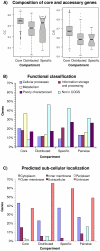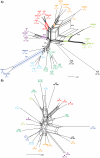Virulence evolution of the human pathogen Neisseria meningitidis by recombination in the core and accessory genome
- PMID: 21541312
- PMCID: PMC3082526
- DOI: 10.1371/journal.pone.0018441
Virulence evolution of the human pathogen Neisseria meningitidis by recombination in the core and accessory genome
Abstract
Background: Neisseria meningitidis is a naturally transformable, facultative pathogen colonizing the human nasopharynx. Here, we analyze on a genome-wide level the impact of recombination on gene-complement diversity and virulence evolution in N. meningitidis. We combined comparative genome hybridization using microarrays (mCGH) and multilocus sequence typing (MLST) of 29 meningococcal isolates with computational comparison of a subset of seven meningococcal genome sequences.
Principal findings: We found that lateral gene transfer of minimal mobile elements as well as prophages are major forces shaping meningococcal population structure. Extensive gene content comparison revealed novel associations of virulence with genetic elements besides the recently discovered meningococcal disease associated (MDA) island. In particular, we identified an association of virulence with a recently described canonical genomic island termed IHT-E and a differential distribution of genes encoding RTX toxin- and two-partner secretion systems among hyperinvasive and non-hyperinvasive lineages. By computationally screening also the core genome for signs of recombination, we provided evidence that about 40% of the meningococcal core genes are affected by recombination primarily within metabolic genes as well as genes involved in DNA replication and repair. By comparison with the results of previous mCGH studies, our data indicated that genetic structuring as revealed by mCGH is stable over time and highly similar for isolates from different geographic origins.
Conclusions: Recombination comprising lateral transfer of entire genes as well as homologous intragenic recombination has a profound impact on meningococcal population structure and genome composition. Our data support the hypothesis that meningococcal virulence is polygenic in nature and that differences in metabolism might contribute to virulence.
Conflict of interest statement
Figures



Similar articles
-
Comparative genomics of Neisseria meningitidis: core genome, islands of horizontal transfer and pathogen-specific genes.Microbiology (Reading). 2006 Dec;152(Pt 12):3733-3749. doi: 10.1099/mic.0.29261-0. Microbiology (Reading). 2006. PMID: 17159225
-
Extensive genomic variation within clonal complexes of Neisseria meningitidis.Genome Biol Evol. 2011;3:1406-18. doi: 10.1093/gbe/evr119. Epub 2011 Nov 14. Genome Biol Evol. 2011. PMID: 22084315 Free PMC article.
-
Transcriptomic buffering of cryptic genetic variation contributes to meningococcal virulence.BMC Genomics. 2017 Apr 7;18(1):282. doi: 10.1186/s12864-017-3616-7. BMC Genomics. 2017. PMID: 28388876 Free PMC article.
-
Living in a changing environment: insights into host adaptation in Neisseria meningitidis from comparative genomics.Int J Med Microbiol. 2007 Nov;297(7-8):601-13. doi: 10.1016/j.ijmm.2007.04.003. Epub 2007 Jun 14. Int J Med Microbiol. 2007. PMID: 17572149 Review.
-
Metabolism and virulence in Neisseria meningitidis.Front Cell Infect Microbiol. 2014 Aug 20;4:114. doi: 10.3389/fcimb.2014.00114. eCollection 2014. Front Cell Infect Microbiol. 2014. PMID: 25191646 Free PMC article. Review.
Cited by
-
The CRISPR/Cas system in Neisseria meningitidis affects bacterial adhesion to human nasopharyngeal epithelial cells.RNA Biol. 2019 Apr;16(4):390-396. doi: 10.1080/15476286.2018.1486660. Epub 2018 Jul 30. RNA Biol. 2019. PMID: 30059276 Free PMC article.
-
The primary transcriptome of Neisseria meningitidis and its interaction with the RNA chaperone Hfq.Nucleic Acids Res. 2017 Jun 2;45(10):6147-6167. doi: 10.1093/nar/gkx168. Nucleic Acids Res. 2017. PMID: 28334889 Free PMC article.
-
Constraints on genome dynamics revealed from gene distribution among the Ralstonia solanacearum species.PLoS One. 2013 May 28;8(5):e63155. doi: 10.1371/journal.pone.0063155. Print 2013. PLoS One. 2013. PMID: 23723974 Free PMC article.
-
Phase-Variable Genotypes Sweetened by Glycosylation Phenotypes.J Bacteriol. 2018 Jul 25;200(16):e00316-18. doi: 10.1128/JB.00316-18. Print 2018 Aug 15. J Bacteriol. 2018. PMID: 29866804 Free PMC article.
-
Attachment and invasion of Neisseria meningitidis to host cells is related to surface hydrophobicity, bacterial cell size and capsule.PLoS One. 2013;8(2):e55798. doi: 10.1371/journal.pone.0055798. Epub 2013 Feb 6. PLoS One. 2013. PMID: 23405216 Free PMC article.
References
-
- Claus H, Maiden MC, Wilson DJ, McCarthy ND, Jolley KA, et al. Genetic analysis of meningococci carried by children and young adults. J Infect Dis. 2005;191:1263–1271. - PubMed
-
- Stephens DS, Greenwood B, Brandtzaeg P. Epidemic meningitis, meningococcaemia, and Neisseria meningitidis. Lancet. 2007;369:2196–2210. - PubMed
-
- Frosch M, Vogel U. Structure and genetics of the meningococcal capsule. In: Frosch M, Maiden MC, editors. Handbook of Meningococcal Disease. Weinheim, Germany: Wiley-VCH; 2006. pp. 145–162.
-
- Harrison LH, Trotter CL, Ramsay ME. Global epidemiology of meningococcal disease. Vaccine. 2009;27(Suppl 2):B51–63. - PubMed
Publication types
MeSH terms
LinkOut - more resources
Full Text Sources
Other Literature Sources

